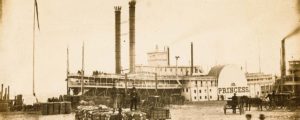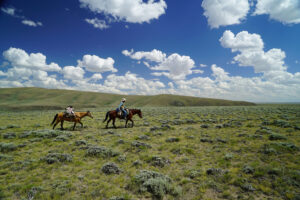In 1859 the Pony Express built a station on Schell Creek in central Utah Territory (present-day Nevada). In June 1860, after raiding Paiute Indians killed the stationmaster and two attendants, the Army established a post (later named Fort Schellbourne for its founding commander, Major A.J. Schell). Soldiers abandoned the fort in 1862 as the Paiute danger subsided.
Elijah Nichols “Uncle Nick” Wilson is credited as the first rider out of the Schell Creek Station for the fledgling Pony Express. He claimed to have survived several skirmishes with Indians and once took an arrow to his head, though he escaped serious injury and arrived at Deep Creek, the terminus of the Schell Creek run, with his mochila of mail intact. (The mochila, leather saddlebags, hung over the flanks of one’s horse, suspended by the saddle horn, which protruded through a hole in the strap.)
When the Pony Express folded in October 1861, the Overland Stage commandeered the station, using it as a regular stop until 1869. Ironically, the station sat on the route of the national telegraph line that helped bring about the eventual demise of the mail service.
In 1865 the local vigilance committee lynched two horse thieves at Schell Creek Station. The rustlers had bludgeoned three men with axes and then tried to obscure the murders by mutilating the victims’ faces and hiding their bodies in the sagebrush. An area rancher rounding up his own stray cattle found the dead men. Searchers soon located the bloodthirsty rustlers and returned them to the station, where they confessed. Vigilantes threw the necktie party for the outlaws a week later, on June 15, 1865.
The Overland stopped running in 1869, but the fort earned a reprieve when prospector James McMahon discovered silver here in early 1871. The assay results were sufficiently rich to merit growth of the “town,” now called Schellbourne. By 1872, in addition to the original stage station and accompanying corrals, the community boasted four or five saloons, two law offices, a Wells Fargo office, two boarding houses, scattered line cabins, a livery stable, two eateries and a mercantile store.
At its peak, the mining camp’s population approached 400. The Schell Creek Prospect rolled out its first edition in July 1872 but only lasted seven months —its brief lifespan reflecting the flyby-night fortunes of the town. Soon, discovery of a more viable silver deposit in Cherry Creek, five miles across SteptoeValley, prompted a mass exodus, as Schellbourne’s miners, stamp mill, equipment and buildings all uprooted and relocated at the new strike site.
Schellbourne wasn’t wholly abandoned. Some miners remained to work on their claims, although the town comprised barely 50 residents. In 1916 The Complete Official Road Guide to the Lincoln Highway referred to it as “a ranch and post office.” The post office finally shut its doors in 1925, when the population dipped below 20.
Time and weather took their toll. By 1999 the old Pony Express station—once packed with wayfarers on the Overland Stage and protected by the soldiers of Fort Schellbourne—had deteriorated beyond repair and was razed. Residents have since torn down other buildings, including the Wells Fargo office, out of concern for safety. The few remaining town ruins are on private property.
To mark the 150th anniversary of the Pony Express, Schellbourne, now centered on the Schellbourne Station Motel & RV Park on US 93, welcomed mounted reenactors. The contemporary riders used GPS signals to pinpoint the station, while teams of historians marshaled them along the old delivery route during daylight hours.
The author expresses his gratitude to June Shaputis for her research on the 1865 Schell Creek Station lynching. Recommended for further reading: Romancing Nevada’s Past, by Shawn Hall.
Originally published in the December 2010 issue of Wild West. To subscribe, click here.




